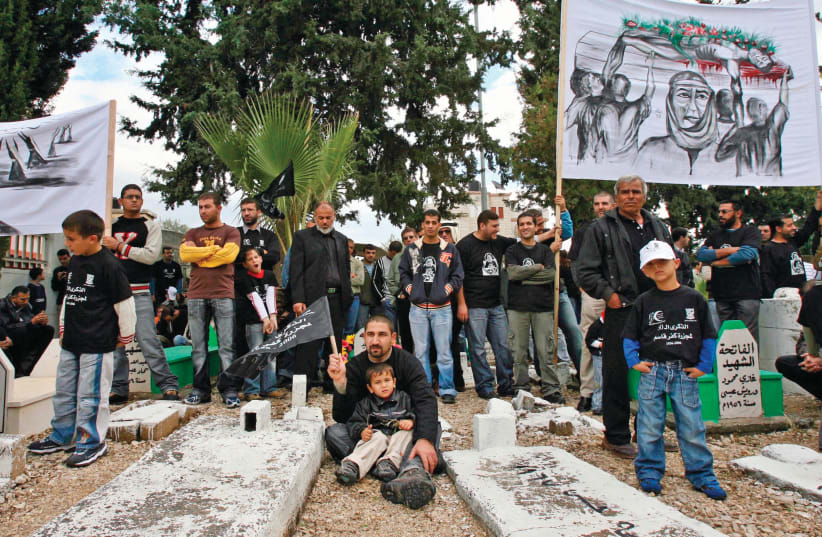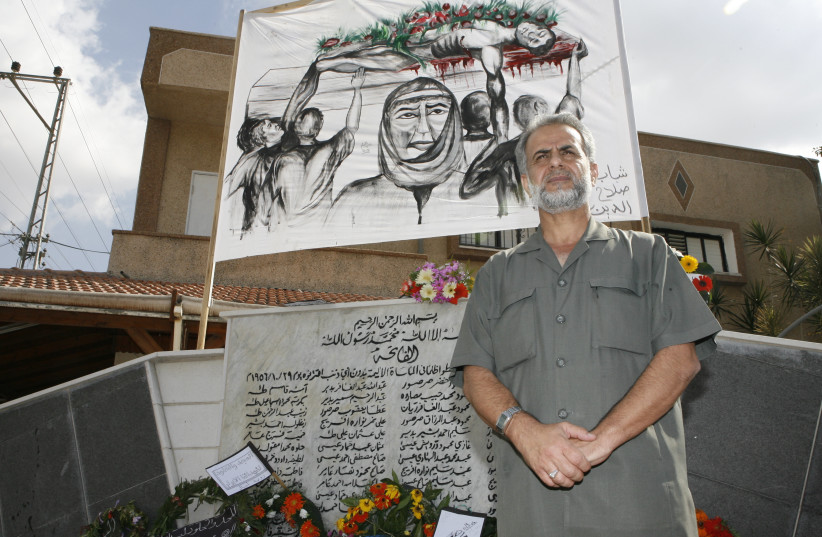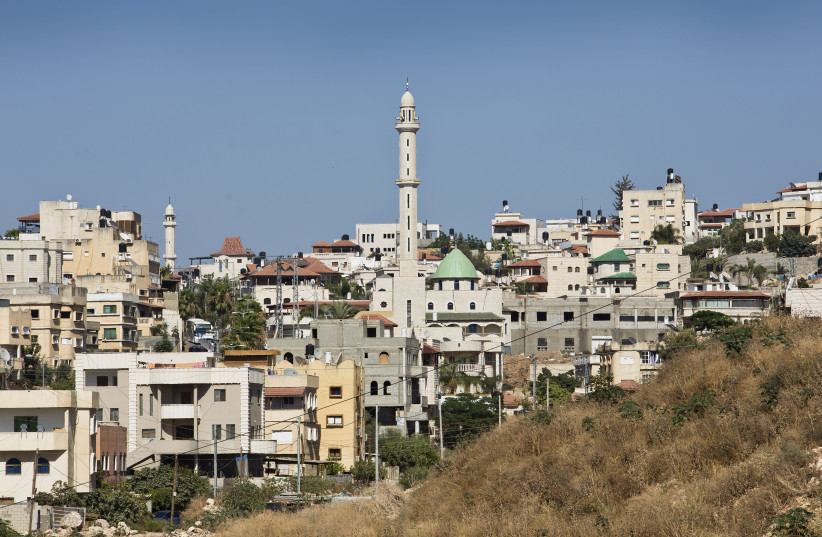The IDF Archives released court documents on Friday from the trial of officers involved in the 1956 Kafr Kassem massacre, in which 49 Arab-Israelis were killed by Border Police officers, shedding new light on the incident.
On October 29, 1956, a curfew was placed on Kafr Kassem and other Arab villages along the border with Jordan on the eve of the Sinai War (Operation Kadesh). However, the commander of the district, Issachar Shadmi, decided on his own to move up the hour when it would start from 9 p.m. to 5 p.m. without warning the villagers who were out working in the fields. Some residents who didn’t know about the change went out of their homes and were shot to death.
In 1957, a number of officers involved in the massacre were put on trial in a military court and some were imprisoned, although one commander who was convicted later returned to command soldiers.
The Kfar Kassem protocols
The protocols released on Friday show that the Border Police commanders held a discussion the day before the massacre about the possibility of conquering Jordan in the upcoming operation, so they were on alert.
The court documents reveal that there were directives to keep the peace and to allow residents returning to be allowed into their homes in the village even after the curfew began if it was moved up to the afternoon from the evening.
The defendants referred multiple times to a plan called Hafarferet (“Mole”), which involved a series of procedures that could be carried out concerning the Arab population in case of war, including pushing Arab residents into Jordan.
Company commander Haim Levy said the plan included measures for curfews, confiscating property that had value for war and moving entire villages from place to place. In the case of Kafr Kassem, the entire population of the village was to be moved to Tira if the plan was implemented.
During questioning, one of the witnesses stressed that Hafarferet was only meant for a situation in which Israel was on the defensive, not for a case like Operation Kadesh, where it was the initiator.
Levy confirmed that there was an explicit order to shoot anyone who broke the curfew, even if they didn’t know that there was one, stressing that the situation had a feeling of “war in the air.” He added that concerning the villagers who were working in the fields at the time, he heard “their judgment is like everyone else’s.”
The company commander added he had been told by battalion commander Shmuel Malinki, “it is desirable that there be a number of casualties” and that if there were deaths on the first day, it would make the rest of the curfew easier. Levy said the forces were told not to put lookouts and checkpoints on the eastern side so that if the Arabs decided to flee, they could and would be allowed to go over the Jordanian border.
Shadmi, the district commander, stated that one of the reasons for the curfew was to ensure that residents didn’t see the IDF soldiers being placed near the border with Jordan and to ensure that they didn’t accidentally walk into the areas where Israeli forces were.
Milinki claimed that when he asked Shadmi how to treat people coming home after the curfew, he was told, “May God have mercy on them.” When asked by an attorney to clarify what he meant, Shadmi said, “The meaning is that he has a lot of chances to die” but added that this was only meant for a situation in which riots broke out.
Soldiers interpreted orders "irrationally"
Multiple witnesses argued that they had issued orders they thought were understandable and that it seemed the soldiers at the scene interpreted those orders “irrationally.”
Shadmi stressed that he assumed any order like this was given to soldiers who “have eyes in their head, and before they shoot they need to think a little.” He added that the curfew served as a substitute for the Hafarferet plan, which was a list of ideas made in order to handle the “uncertain loyalties” of the Arab population.
Gabriel Dahan, the commander of the department operating in Kfar Qassem, said he was told by Melinki “without sentiments, it is better to have a few dead, so that there will be peace in the area. He emphasized that there will be no murder, but killing. I understood from his words that this is in accordance with the order and this murder – if I deviate from the order.”
Dahan added that he entered the village after the curfew started, telling a squad at the western side to allow any people who were seen coming to the village to pass without being harmed. After seeing people still outside, Dahan fired in the air and shouted in Arabic for them to go into their homes. Meanwhile, a squad shot and killed an Arab north of Kafr Kassem who was approaching the village.
The commander added that within the next half hour, he heard shots throughout the village and found at least 30 Arabs killed on the western side. The police officer stationed there told him that he told them to get out of their cars and that they had proceeded to run away so he shot and killed them. In his testimony, Dahan stated that the officer was known to him as a “hot-tempered guy” who had used his weapon carelessly several times.
Israel must acknowledge responsibility, Arab MKs say
Joint List MK Aida Touma-Sliman responded to the release of the protocols on Friday, saying, “Today what we said from the first day was revealed: The shocking massacre in Kafr Kassem in 1956 was a deliberate murder, part of a plan to deport the residents of the Triangle!
“The published protocols prove that Israel not only murdered 50 Arab citizens in cold blood but also planned the ‘establishment of pens’ and the ‘transfer of the people’ – not only in 1948 but also under the military regime in the 1950s,” she said.
על מדינת ישראל להכיר באחריותה באופן רשמי לטבח. הכרה בפשעי העבר היא שלב הכרחי בדרך לתיקון העוול ההיסטורי והבסיס לעתיד משותף.
— MK Aida Touma-Sliman (@AidaTuma) July 29, 2022
“The State of Israel must officially acknowledge its responsibility for the massacre. Acknowledging the crimes of the past is a necessary step on the way to correcting the historical injustice and the basis for a common future.”
Regional Cooperation Minister Esawi Frej responded to the publication as well, saying, “I’m finally reading the words I’ve dreamed of reading all my life. The evidence of the planned murder, on the eastern gate of Kafr Kassem, was left open in the hope that the survivors would understand the message and escape. But next to the pain there is also peace.
“After 66 years, the truth comes out. For so long, our country sought to hide from us the truth about the massacre that hurt every family in Kafr Kassem, including my family, and continued to accompany us to this day,” he lamented. “Now the truth is out; so is the deportation plan [Hafarferet] – although not officially published, it is present on every page of the trial protocol.”
כל כך הרבה זמן המדינה שלנו ביקשה להסתיר מאתנו את האמת על הטבח שפגע בכל משפחה בכפר קאסם, גם במשפחתי ונוכח בחיינו עד היום. כעת האמת בחוץ, כך גם תכנית הגירוש (חפרפרת), שאף אם לא פורסמה רשמית, נוכחת בכל אחד מדפי פרוטוקול המשפט.אחרי בקשת הסליחה, ולאחר פרסום הפרוטוקולים >>
— Esawi Frej عيساوي فريج עיסאווי פריג (@EsawiFr) July 29, 2022
Frej called for the massacre to be taught in school curriculums to every boy and girl, Jewish or Arab.
“For years, the state has come up with countless excuses to hide the truth from us,” he said. “Today the obvious was revealed; that there is nothing like the truth to ease the pain, to help build the common future, to give hope.”


